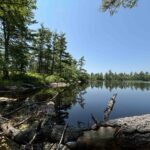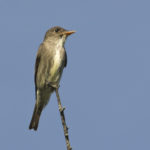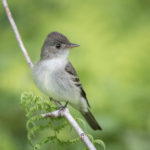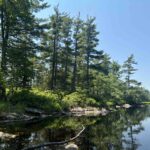Expanding for Blanding’s on Pleasant River
31 Jul 2024
The beloved – and very vulnerable – Blanding’s Turtles have another 86 acres of protected habitat!
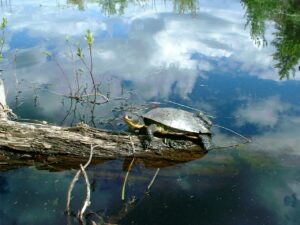
Blanding’s Turtle on log (photo credit: Jeffie McNeil)
Blanding’s Turtles have a similar lifespan to humans: over eighty years – if they make it to adulthood. With much of their habitat lost to human activities and climate change, as well as increasing risks from cars and other vehicles, Blanding’s Turtles are at risk of extinction in Nova Scotia and across Canada. Thankfully, experts believe that recovery for this endangered species is still possible, and one of the most important things we can do to help is to protect their critical habitat.
The newly protected property is comprised of two parcels totaling 86 acres (34.8 hectares) in size. Located along the Pleasant River in the Mi’kmaw district of Kespukwitk, the property borders the Pu’tlaqne’katik Wilderness Area and is very close to other conservation lands within the Nature Trust’s Pu’tlaqne’katik focus area. Like the other protected lands in this area, the property lies within mapped critical habitat for the Pleasant River population of Blanding’s Turtle, which is listed as Endangered under both the federal Species at Risk Act and the Nova Scotia Endangered Species Act.
The property includes extensive shoreline and intact riparian (riverside) habitat on the Pleasant River. It supports a beautiful mature red maple swamp along the river, with trees likely older than 150 years. The interior has been cleared in many areas and once was used as a Christmas tree farm; as conservation land under the Nature Trust’s care, the once cultivated areas of the property will slowly revert to a wilder state.
Besides Blanding’s Turtles, the property also provides habitat for Evening Grosbeaks, Olive-sided Flycatchers, Eastern Wood-Pewee, and potentially other at-risk birds and rare lichens.
This project was undertaken with the financial support of the Government of Canada through the federal Department of Environment and Climate Change’s Priority Places for Species at Risk Program.
This property was protected through our Twice the Wild campaign, which reached its goal of doubling the protected acres under our care in June 2024.


